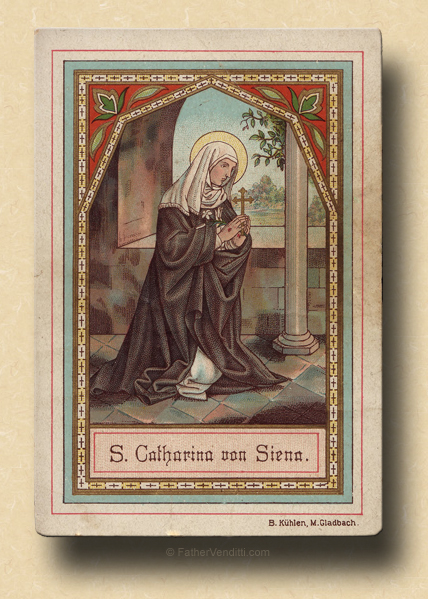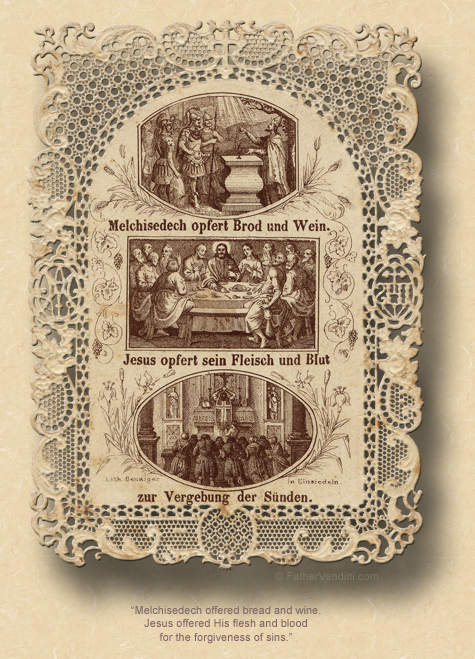Time to Let Our Priests be Priests.
The Memorial of Saint Catherine of Siena, Virgin & Doctor of the Church.
Lessons from the feria, according to the ordinary form of the Roman Rite:
• Acts 6: 1-7.
• Psalm 33: 1-2, 4-5, 18-19.
• John 6: 16-21.
|
…or, from the proper:
• I John 1: 5—2: 2.
• Psalm 103: 1-4, 8-9, 13-14, 17-18.
• Matthew 11: 25-30.
…or, any lessons from the common of Virgins.
|
The Third Class Feast of Saint Peter of Verona, Martyr.*
Lessons from the common "Protexísti…" of a Martyr during Easter, according to the extraordinary form of the Roman Rite:
• II Timothy 2: 8-18; 3: 10-12.
• [The Gradual is omitted.]
• John 15: 1-7.
Thomas Saturday; the Feast of the Nine Holy Martyrs of Cyzice; and, the Feast of Our Venerable Father Memnon the Wonderworker.**
Lessons from the pentecostarion, according to the Ruthenian recension of the Byzantine Rite:
• Acts 5: 5: 21-33.
• John 6: 14-27.
FatherVenditti.com
|
 7:48 AM 4/29/2017 — I've always had great affection for Saint Catherine of Siena, probably because I'm attracted to annoying people like they were kindred souls. And annoying she was to those who crossed her, be they priests or bishops or other nuns or even popes. She was also quite brilliant, even though she had no formal education; and, her spiritual writings were of such an influential nature on Pope Blessed Paul VI that he proclaimed her a Doctor of the Church, a title usually reserved for saints who were the most erudite of theologians. Pope Pius II, who canonized her, was of the opinion that her learning was not acquired, but infused, suggesting that she received her wisdom directly from God. 7:48 AM 4/29/2017 — I've always had great affection for Saint Catherine of Siena, probably because I'm attracted to annoying people like they were kindred souls. And annoying she was to those who crossed her, be they priests or bishops or other nuns or even popes. She was also quite brilliant, even though she had no formal education; and, her spiritual writings were of such an influential nature on Pope Blessed Paul VI that he proclaimed her a Doctor of the Church, a title usually reserved for saints who were the most erudite of theologians. Pope Pius II, who canonized her, was of the opinion that her learning was not acquired, but infused, suggesting that she received her wisdom directly from God.
A lot of people make the mistake of believing she was a Dominican because she's often portrayed in devotional art as wearing a Dominican habit; in reality, she belonged to a community called the Sisters of Penance, who practiced a Dominican spirituality and borrowed the design of their habit from the Dominicans; in fact, if I'm not mistaken, the Dominicans actually claim her as their own as a tertiary, and they've gotten away with it for so many centuries that nobody challenges them on it.
She entered religious life at a very young age and, in response to a vision she received one day after taking Holy Communion, practiced a very strict austerity for the rest of her young life, until she went home to God in the year 1380 at the tender age of thirty-three. Many people are not aware that she was a stigmatist, and the reason they are not aware of that is because her stigmata was invisible: she did not have visible wounds that one could see, like Padre Pio or Saint Francis at the end of his life; her wounds could not be seen, but were just as painful; but, she never made a big deal about it, often simply concealing the fact from those around her.
But even the suffering of her stigmata didn't stop her from being annoying, especially to Pope Gregory XI. From 1309 to 1377, the popes had abandoned the city of Rome and lived under the untoward influence of the Kings of France. The hand Missal I sometimes use to prepare for Mass has little three or four line biographies of the saint of the day, and the one for Saint Catherine is particularly sanitized: it says that she “was instrumental in the return of Pope Gregory XI from Avignon to Rome. In word and deed, she showed her love for God's Church and the Roman Pontiff.” Well, if she was showing love for the Roman Pontiff, it was definitely “tough love”; she badgered that poor man to the point that he just couldn't take it anymore, and returned the papacy to Rome probably just to get her off his back. And it was a good thing, too, because she knew what all the doctors of Canon Law in her day failed to understand: that a pope who isn't in Rome isn't really a pope. It's being the Bishop of Rome that makes a man pope; and, if we are of a mind to regard it a good thing that the Holy Father stands apart from politics and the influence of governments, we have Saint Catherine of Siena to thank for it.
Her memorial day is the perfect occasion to renew our dedication to the Holy Father and to pray for him, and her example, I think, is particularly prescient now. That being said, it's important to recognize how Saint Catherine got away with yelling and screaming at a pope: she got away with it because the holiness of her life was so obvious. The degree of penance she practiced in her daily life was so profound, that no theological argument could possibly speak as clearly as the example of her life. Pope Gregory could have easily ignored the arguments of some disgruntled nun with a degree in theology, but he couldn't argue with a saint; nobody can.
Now let’s turn our attention to the Apostolic lesson of today's Mass, which is the ordination of the first deacons, but which, when you look at the reading from Acts carefully, is much more about priests than about deacons.
What is the reason the Twelve give for the ordination of the Church's first seven deacons? They say, “It is not right for us to neglect the word of God to serve at table” (Acts 6: 2 NABRE). They were not running a restaurant. The Church, as it does to this day, cared for the poor; at Holy Mass, collections were taken up, just as they are today, and much of what was collected went to those in need, and this required a lot of footwork.  The Apostles had been doing it all themselves, but it soon became clear that they couldn't give enough attention to preparing for and celebrating the sacred mysteries if they also had to be involved in all these charitable activities; so, the deacons were ordained to do this sort of work for them. The Apostles had been doing it all themselves, but it soon became clear that they couldn't give enough attention to preparing for and celebrating the sacred mysteries if they also had to be involved in all these charitable activities; so, the deacons were ordained to do this sort of work for them.
And what's important for us to notice is that, even in the time of the Apostles, there is already a well-defined division of labor in the Church: the job of the priest is to offer sacrifice and preach the Word of God; the more pragmatic duties of the Church are given to others, and specifically for the reason of leaving the priests free to perform their sacred functions.
I was a pastor for many years, and one of the most frustrating things about being a pastor is that most of what you do has nothing to do with being a priest: you are a maintenance man, you are an accountant, you are social worker, you are a marriage counselor, you are a fund raiser, you are everything except what you were ordained to be, which is a preacher of the Word and an offer-er of sacrifice. When Pope Blessed Paul VI reinstated the diaconate as a permanent ministry in the Church, no longer restricting it to those in preparation for the priesthood, his idea was to correct this problem; but, it didn't turn out that way, as most of the deacons ordained since then are all married men with jobs and lives of their own, and whose diaconate is more or less restricted to helping out at Holy Mass on Sundays, which, as you can see from today's first lesson, has nothing to do with what they were originally ordained to do.
What I want to offer for your reflection today is a simple and brief appeal to not only pray for priests every day, which I'm sure you do, but also encourage you to make a resolution to let your priests be priests. The Holy Priesthood is not an office of authority, but an office of service; he stands in the place of Christ as a victim for sin, one who leads us in prayer and presents to Almighty God the offering of sacrifice for the remission of sin on behalf of the souls entrusted to his care; and we should not attempt to draw him out of the role.
I think it's important to meditate frequently on the last line of today's lesson; for, what was the result of the ordination of the deacons? What did the commission to these seven men to assume the more mundane tasks of the Church do? “The word of God continued to spread, and the number of disciples in Jerusalem increased greatly; even a large number of priests were becoming obedient to the faith” (6: 7 NABRE). Saint Luke is, of course, speaking of Jewish priests in that last sentence, but the irony of his choice of words should not be lost on us. If we have ever been concerned about the holiness of our priests, if we have ever wondered why this priest or that whom we may know is not what we think he should be as a priest of Jesus Christ, one of the reasons may be that we keep expecting him to be what he is not. After the example of our Lord, the priest is ordained to guide, to teach, and to sanctify. Everything else is—or at least should be—irrelevant for him.
So, let us pray for our priests, but—even more importantly—let us also resolve to let our priests be priests.

* Peter of Verona was a famous preacher of the Dominican order. From childhood he was conspicuous for his refutation of heretics and his singular innocence. He longed to die for the faith, and his prayer was heard in 1252.
In the extraordinary form, Catherine of Siena is observerd tomorrow, suppressed this year because it falls on the Sunday.
** The martyrs of Cyzica were put to death in 322 or 323.
Memnon was hegumen (abbot) of a monastery in Egypt sometime in the second century. He is said to have performed a number of miracles, including causing a spring to gush forth, destroying a plague of locusts, curing illnesses and saving boats from destruction.
|

